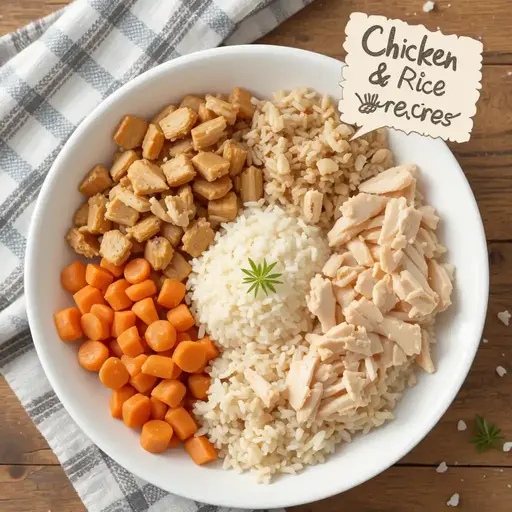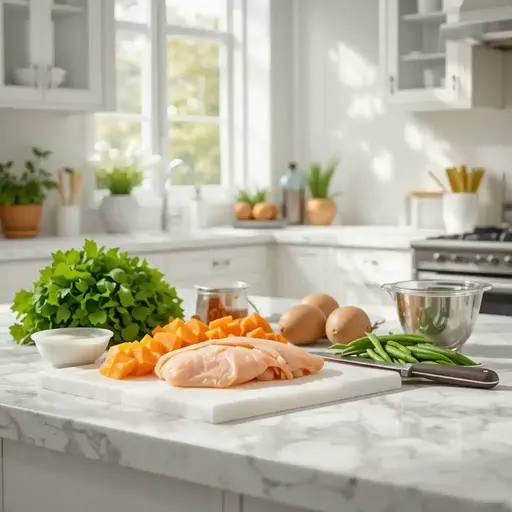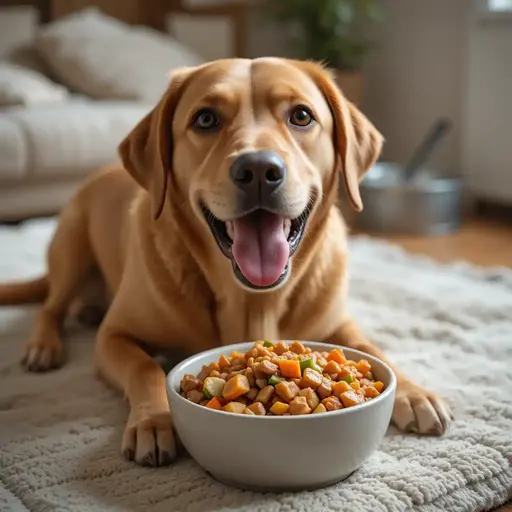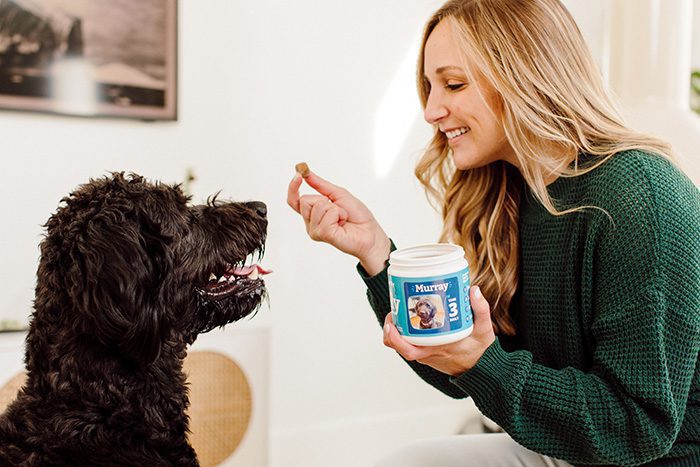Low‑fat dog food recipes for pancreatitis give your pup the nutrients it needs while keeping pancreatic stress to a minimum. By limiting dietary fat to < 10 % on a dry‑matter basis, these meals help calm inflammation, speed recovery, and lower the chance of future flare‑ups.
Below you’ll find a step‑by‑step guide to choosing the right diet, five vetted recipes, safe preparation tips, common pitfalls, and answers to the most‑asked questions.
What Is Pancreatitis in Dogs?
Pancreatitis is inflammation of the pancreas, the organ that makes digestive enzymes and insulin. It can appear acutely (sudden, severe pain) or chronically (repeated, milder episodes).
Typical triggers
- High‑fat meals or table scraps
- Obesity or rapid weight gain
- Certain medications (e.g., steroids, some diuretics)
- Underlying diseases such as hyperlipidemia or diabetes
Clinical signs you should watch for
| Sign | What it looks like |
|---|---|
| Vomiting | Repeated episodes, sometimes with bile |
| Diarrhea | Loose, often with a foul odor |
| Loss of appetite | Reluctance to eat or drink |
| Lethargy | Low energy, resting more than usual |
| Abdominal pain | Hunched posture, “praying” stance, whine when touched |
| Dehydration | Dry gums, skin that stays tented |
Prompt veterinary care is essential; early detection can prevent complications such as pancreatic necrosis or systemic infection.

Why Low‑Fat Diets Are Critical for Pancreatitis Management
The pancreas releases enzymes to digest fats, proteins, and carbs. When it’s inflamed, extra fat forces the organ to work harder, worsening pain and prolonging healing. A low‑fat diet works by:
- Reducing enzyme demand – Less fat means the pancreas produces less lipase, allowing inflamed tissue to rest.
- Improving digestibility – Simple carbs (rice, sweet potato) and lean proteins are easy for the gut to handle, decreasing gastrointestinal upset.
- Supporting weight control – Lower‑calorie, low‑fat meals help maintain an ideal body condition, a major risk factor for recurrent pancreatitis.
Veterinarians typically aim for fat < 10 % (dry‑matter basis) and high‑quality, highly digestible protein.
Commercial vs. Homemade Low‑Fat Dog Food for Pancreatitis
Pros and Cons of Commercial Diets
| Advantages | Drawbacks |
|---|---|
| Convenient – No daily cooking, just scoop & serve. | Higher cost – Prescription formulas can be pricey. |
| Nutritionally complete – Formulated to meet AAFCO standards. | Processing – May contain preservatives or additives some owners dislike. |
| Consistent – Same nutrient profile in every bag. | Limited customization – Hard to adjust for individual allergies or preferences. |
| Veterinary‑approved – Many are prescription‑only, ensuring proper fat levels. | Palatability – Some dogs in recovery may be picky. |
Benefits and Challenges of Homemade Recipes
| Benefits | Challenges |
|---|---|
| Full ingredient control – You choose each component, eliminating unknowns. | Time‑intensive – Shopping, cooking, and portioning each day. |
| Tailorable – Adjust protein source, carbs, or add supplements as needed. | Nutrient balance – Requires a vet‑approved formula to avoid deficiencies. |
| Freshness – No artificial preservatives, often more appealing taste. | Consistency – Small measurement errors can shift fat or protein percentages. |
| Potential cost savings – Bulk proteins and carbs can be cheaper. | Storage – Must freeze or refrigerate meals safely. |
Quick Comparison
| Feature | Commercial Low‑Fat Diet | Homemade Low‑Fat Recipes |
|---|---|---|
| Ease of use | ✔️ Very easy | ❌ Requires cooking |
| Nutritional completeness | ✔️ Guaranteed (if AAFCO‑rated) | ❌ Needs vet/nutritionist input |
| Ingredient transparency | ⚠️ Labels may be vague | ✔️ You see everything |
| Cost | ⚖️ Higher per‑day | ⚖️ Variable, often lower |
| Customization | ❌ Limited | ✔️ Unlimited |
When to Choose Each Option
- Busy schedules or travel – Commercial therapeutic foods are the safest, most reliable choice.
- Budget‑tight households – Homemade meals can be cheaper if you buy protein in bulk and plan.
- Multiple food sensitivities – Homemade recipes let you eliminate specific allergens.
- Acute flare‑up – Vets often start with a prescription diet for rapid, digestible nutrition; transition to homemade later if desired.

Low‑Fat Dog Food Recipes for Pancreatitis: Top 5 Homemade Meals
The following recipes meet the low‑fat dog food recipes for pancreatitis guideline of < 10 % fat (dry matter) and provide balanced protein, carbs, and fiber. Always run new meals past your vet and adjust portion sizes to your dog’s weight and activity level.
Chicken & Rice (Classic Bland Diet)
Ingredients
- 1 lb (450 g) skinless, boneless chicken breast, diced
- 2 cups (400 g) white rice (or 1.5 cups brown rice for extra fiber)
- 2 cups low‑sodium chicken broth or water
- 1 tsp (5 ml) olive oil, optional for dogs needing extra calories (keep total fat < 10 %)
Instructions
- Place chicken in a pot, cover with broth, bring to a boil, then simmer 15‑20 minutes until fully cooked.
- While chicken cooks, rinse rice, then simmer in 3 cups water (or broth) until tender (18 min white, 30 min brown).
- Shred chicken finely, combine with rice, and stir in olive oil if using.
- Cool to room temperature before serving.
Storage – Refrigerate ≤ 3 days or freeze in ½‑cup portions up to 2 months.
Turkey & Sweet Potato Medley
Ingredients
- 1 lb (450 g) extra‑lean ground turkey (≥ 93 % lean)
- 2 medium sweet potatoes, peeled & cubed
- 1 cup frozen green beans, thawed & chopped
- 2 cups low‑sodium turkey broth or water
Instructions
- Boil sweet potato cubes until fork‑tender (≈ 15 min); mash lightly.
- In a skillet, brown turkey with ½ cup broth, breaking it up until no pink remains.
- Add remaining broth and green beans; simmer 10 min.
- Mix mashed sweet potatoes with turkey‑bean mixture; cool before serving.
Storage – Same as Recipe 1.
White Fish & Veggie Blend
Ingredients
- 1 lb (450 g) skinless cod, haddock, or pollock fillets
- 2 cups carrots, diced
- 1 cup zucchini, diced
- ½ cup green beans, chopped
- 1½ cups cooked white rice
- 2 cups low‑sodium fish or vegetable broth
Instructions
- Boil vegetables in broth until soft (≈ 12 min). Drain, reserving ¼ cup liquid.
- Poach fish in the same broth (or bake at 350 °F for 12‑15 min) until flaky; remove bones.
- Flake fish, combine with vegetables, rice, and reserved liquid for the desired consistency.
- Cool completely before serving.
Storage – Refrigerate ≤ 3 days; freeze in ½‑cup portions for up to 3 months.
Lean Beef & Brown Rice Mix
Ingredients
- 1 lb (450 g) extra‑lean ground beef (≥ 93 % lean)
- 1½ cups uncooked brown rice
- 1 cup fresh spinach, stems removed & chopped
- ½ cup frozen peas, thawed
- 2 cups low‑sodium beef broth or water
Instructions
- Cook brown rice in 3 cups of broth (≈ 35 min).
- Brown ground beef in a skillet with ½ cup broth; drain excess fat.
- Add remaining broth, spinach, and peas; simmer 5‑7 min until spinach wilts.
- Stir rice into the meat‑veg mixture; cool before serving.
Storage – Same as above.
Lamb & Pumpkin Delight
Ingredients
- 1 lb (450 g) trimmed lean lamb shoulder or leg, cut into cubes
- 1 cup plain canned pumpkin (unsweetened)
- 1½ cups cooked white rice
- ½ cup carrots, diced
- 2 cups low‑sodium chicken or lamb broth
Instructions
- Simmer lamb cubes in broth until tender (≈ 1.5‑2 h) or bake at 325 °F for 1 hour.
- Boil carrots until soft (≈ 10 min).
- Shred the cooked lamb, discard excess fat, and combine with carrots, pumpkin, and rice.
- Add a splash of cooking liquid for moisture; cool before serving.
Storage – Refrigerate ≤ 3 days; freeze as needed.
How to Prepare Low‑Fat Dog Food at Home
Choosing the Right Ingredients
| Category | Recommended Options | What to Avoid |
|---|---|---|
| Protein | Skinless chicken, turkey breast, extra‑lean ground beef, white fish (cod, haddock), trimmed lean lamb | Fatty cuts, skin, processed meats, bacon, sausage |
| Carbohydrates | White rice, brown rice, sweet potato, pumpkin, oatmeal (plain) | Cornmeal, wheat flour (high gluten), sugary cereals |
| Vegetables | Carrots, green beans, zucchini, spinach, peas (cooked) | Onions, garlic, avocado, mushrooms |
| Fats | Minimal olive oil or fish oil (under vet guidance) | Butter, cheese, oil-heavy sauces |
Key rules
- Trim all visible fat before cooking.
- Never add salt, pepper, herbs, or spices – they can irritate the gut or be toxic.
- Use low‑sodium broths to keep flavor without extra salt.
Cooking Methods that Keep Fat Low
- Boiling or poaching – cooks protein in water, leaches out remaining fat.
- Steaming vegetables preserves nutrients and prevents added oil.
- Baking (covered) – can replace frying while retaining moisture.
Avoid sautéing in oil or grilling with high‑fat marinades.
Portioning and Storing Safely
- Cool food to room temperature – prevents condensation in containers.
- Store in airtight containers – 3‑4 days in the refrigerator, up to 3 months frozen.
- Label each batch with date and recipe name.
- Defrost in the refrigerator or use the microwave’s defrost setting; never refreeze thawed food.
- Warm slightly (optional) before serving – make sure it’s lukewarm, never hot.

Common Mistakes When Feeding Dogs with Pancreatitis
Giving High‑Fat Treats
Even a small bite of cheese or a piece of bacon can push dietary fat over the safe threshold, renewing pancreatic inflammation. Choose low‑fat alternatives such as:
- Small pieces of boiled chicken breast
- Baby carrots or green beans (steamed)
- Commercial “low‑fat” treats that list < 5 % fat on the label
Treats should never exceed 10 % of daily calories for a dog with pancreatitis.
Switching Foods Too Quickly
A sudden diet change can overload the gut, causing vomiting or diarrhea—both dangerous for a recovering pancreas. Follow a 10‑day transition plan:
| Day Range | New Food % | Old Food % |
|---|---|---|
| 1‑2 | 25 % | 75 % |
| 3‑4 | 50 % | 50 % |
| 5‑6 | 75 % | 25 % |
| 7‑10 | 100 % | 0 % |
Monitor stool quality and appetite; pause or slow the transition if issues arise.
Ignoring Nutritional Gaps
Homemade meals can lack essential nutrients (e.g., calcium, omega‑3 fatty acids, vitamins). Work with a veterinary nutritionist to add:
- Calcium source – finely ground eggshell powder or a calcium supplement.
- Omega‑3 – a modest amount of fish oil (vet‑approved dosage).
- B‑complex – especially B12 if chronic pancreatitis is present.
Never self‑prescribe supplements; incorrect dosing can harm your dog.
Over‑Supplementing
Too much calcium or fat can negate the benefits of a low‑fat diet. Keep supplement amounts within the range your vet recommends and re‑evaluate during follow‑up appointments.
Skipping Regular Veterinary Check‑Ups
Pancreatitis can recur silently. Routine blood work, weight checks, and ultrasound assessments help catch early signs before they become emergencies.
Benefits of Low‑Fat Dog Food for Pancreatitis
Improved Digestion & Reduced Inflammation
- Less enzymatic workload – Low fat means the pancreas produces fewer lipase enzymes, giving inflamed tissue a chance to heal.
- Easier nutrient absorption – Simple carbs and lean protein are digested quickly, reducing gastrointestinal upset.
- Lowered systemic inflammation – Fat reduction can diminish the release of inflammatory mediators throughout the body.
Weight Management & Overall Health
- Prevents obesity – A low‑fat diet naturally reduces excess calories, helping maintain an ideal body condition score (BCS).
- Decreases risk of recurrence – Dogs at a healthy weight are less likely to experience another pancreatitis episode.
- Supports metabolic health – Stable weight improves insulin sensitivity and reduces the chance of secondary conditions like diabetes.
FAQs
Can I feed my dog a regular commercial low‑fat kibble instead of prescription food?
Regular low‑fat kibble may not meet the strict < 10 % fat requirement or provide the highly digestible protein needed for pancreatitis. Prescription diets are formulated to this standard, so always ask your vet before switching.
How long should my dog stay on a low‑fat diet after recovery?
Most vets recommend maintaining a low‑fat diet for life, especially if your dog has had chronic or recurrent pancreatitis. Some owners may transition to a moderate‑fat diet after several months, but only under veterinary guidance.
Are supplements like pancreatic enzymes ever necessary?
If the pancreas is unable to produce enough enzymes, a vet may prescribe pancreatic enzyme tablets to aid digestion. This is common in chronic cases but should never be added without veterinary direction.
My dog loves treats—how can I give low‑fat rewards safely?
Offer tiny pieces of boiled chicken breast, dehydrated sweet‑potato chews, or low‑fat commercial treats formulated for gastrointestinal health. Keep treats to ≤ 10 % of total daily calories to avoid upsetting the pancreas.
What signs indicate my dog’s low‑fat diet isn’t working?
Watch for recurring vomiting, persistent diarrhea, lethargy, or abdominal pain. Any of these symptoms should prompt a call to your veterinarian, as they may signal a flare‑up or an imbalance in the diet.
Conclusion
Low‑fat dog food recipes for pancreatitis give you control over fat content, nutrient balance, and flavor—critical factors in easing pancreatic inflammation and preventing relapse.
Whether you choose a vetted commercial therapeutic diet or craft homemade meals using the five recipes above, keep fat below 10 % (dry matter), transition slowly, and stay in close contact with your veterinarian.
A disciplined, low‑fat feeding plan not only supports recovery but also promotes healthy weight and long‑term well-being. Start today by picking one of the recipes, preparing a small batch, and discussing it with your vet—you’ll be one step closer to a happier, healthier pup.






